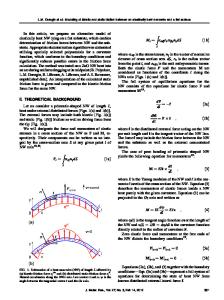Electronic and Mechanical Coupling in Elastically Bent ZnO Micro/Nanowires
- PDF / 7,139,002 Bytes
- 11 Pages / 612 x 792 pts (letter) Page_size
- 84 Downloads / 325 Views
Electronic and Mechanical Coupling in Elastically Bent ZnO Micro/Nanowires Xuewen Fu1, Zhimin Liao1 and Dapeng Yu1* 1
State Key Laboratory for Mesoscopic Physics, and Electron Microscopy Laboratory, Department of Physics, 209 Chengfu Road, Peking University, Beijing 100871, China E-mail: [email protected] ABSTRACT Elastic engineering strain has been regarded as a low-cost and continuously variable manner for altering the physical and chemical properties of materials, and it becomes even more important at low-dimensionality because at micro/nanoscale, materials/structures can usually bear exceptionally high elastic strains before failure. The elastic strain effects are therefore greatly magnified in micro/nanoscale structures and should be of great potential in the design of novel functional devices. The purpose of this overview is to present a summary of our recently progress in the energy band engineering of elastically bent ZnO micro/nanowires. First, we present the electronic and mechanical coupling effect in bent ZnO nanowires. Second, we summary the bending strain gradient effect on the near-band-edge (NBE) emission photon energy of bent ZnO micro/nanowires. Third, we show that the strain can induce exciton fine-structure splitting and shift in ZnO microwires. Our recent progresses illustrate that the electronic band structure of ZnO micro/nanowires can be dramatically tuned by elastic strain engineering, and point to potential future applications based on the elastic strain engineering of ZnO micro/nanowires. INTRODUCTION
Artificial modulation of the electronic band structures at atomic scale is an essential approach to improve the physical and chemical properties of materials, and is imperative for application in design of modern novel functional devices. Elastic strain, the ratio of total deformation to the initial dimension of a material element bearing loadings, has been regarded as a low-cost and continuous variable manner for altering the physical and chemical properties of materials[1]. It is a universal phenomenon accompanying the synthesis and fabrication of materials or the functional devices. Especially, it is found that when the materials enter micro- and nano-scale, such as micro/nano-sheets and micro/nano-wires, they are much more flexible and can avoid inelastic relaxation up to a significant fraction of their ideal strength comparing to their bulk-scale materials, which are termed as “ultra-strength materials” [2, 3]. For instance, it is demonstrated experimentally that both the monolayer graphene and molybdenum disulphide (MoS2) membrane could bear the in-plane elastic strain up to 25%[3, 4] and 11%[5],respectively. Wong et al. found that the strengths of the SiC nanorods were substantially greater than those found previously for SiC bulk structure[6]. Wang et al. experimentally illustrated that the silicon nanowires can sustain 14.3% bending stain without crack[7], and Wei et al. also found that the ZnO nanowires can be elastically stretched to 7.3% without rupture[8]. The large elastic strai
Data Loading...











